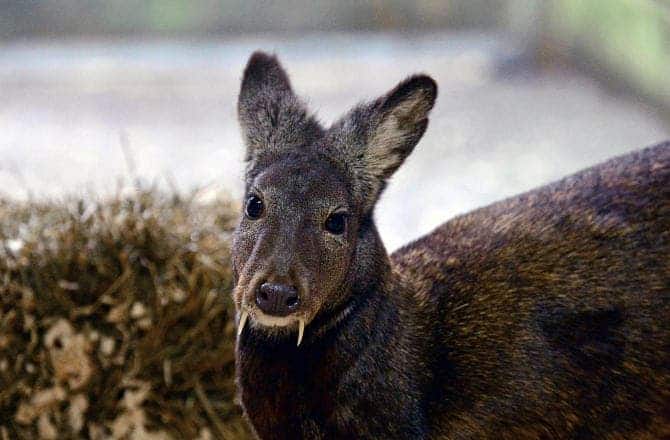Take a look at this magnificent fanged deer – this is not some Hollywood production or imaginary creature, this is a genuine Kashmir Muskdeer (Moschus cupreus), previously thought to be extinct, and now observed for the first time in 60 years in the forests of Afghanistan.

There are actually several species of fanged deer, the most known one being water deer (Hydropotes inermis); their prominent tusks have led to it being colloquially named the vampire deer in English-speaking areas to which it has been imported. Despite its lack of antlers and certain other anatomical anomalies—including a pair of prominent tusks (downward-pointing canine teeth), it is classified as a cervid. All fanged deer have quite unique characteristics, which is why they have their own genus.
The males alone have fangs, which are used as a display strategy in breeding season. For deer, they are small and a bit stocky, measuring just over 2 feet (60 cm) at the shoulders.
The Kashmir musk deer is an endangered species, mostly due to habitat loss and poaching. The deer has a very high price on the black market, often being poached specifically for its scent glands. The glands produce a produce a potent chemical that can value them more than $20,000 per pound.
Many believed that the species was extinct. After all, despite some anecdotes, there was no official sighting for over 60 years. But now, scientists report not one, but five sightings, which gives them reasons to be optimistic. A solitary male was spotted three times, and a female with a juvenile were also reported.
“Musk Deer are one of Afghanistan’s living treasures” lead author of the study, Peter Zahler says. “This rare species, along with better known wildlife such as snow leopards, are the natural heritage of this struggling nation.”
“We hope that conditions will stabilize soon to allow WCS and local partners to better evaluate conservation needs of this species.”
Even though it’s not clear what the situation is, scientists are optimistic regarding a potential resurgence of the rare species. Unfortunately, none of the creatures stayed still long enough to take a picture.
The results were published in the Journal Oryx.


